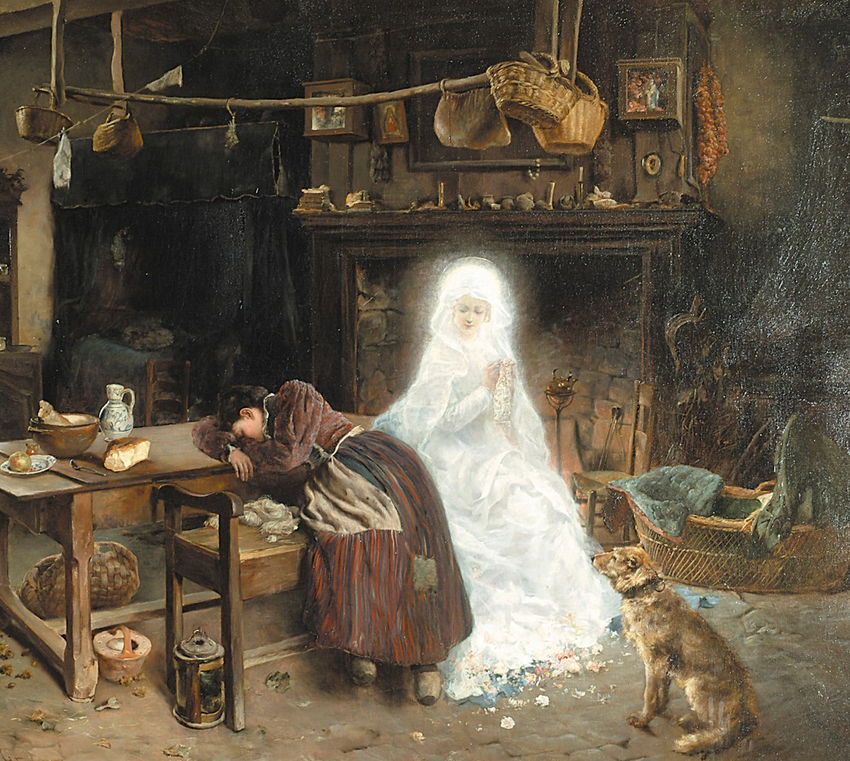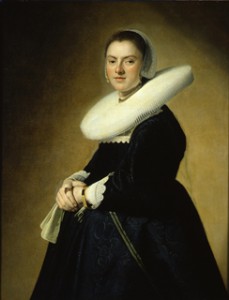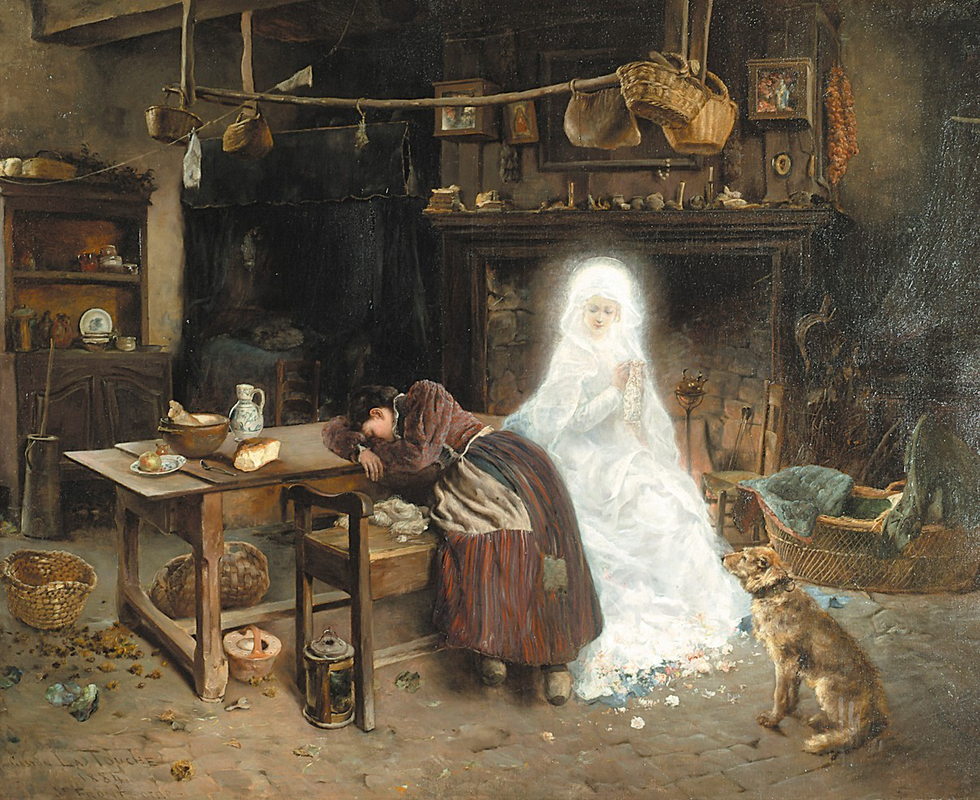
Gaston La Touche, ‘The Legend of Argentan Point Lace’, 1884. Musée des Beaux-arts et de la Dentelle, Alençon
The Virgin Mary finishes the task of a young lacemaker, too exhausted to continue the work herself. This painting, first exhibited in 1884, now adorns the walls of the Museum of Fine Art and Lace in Alençon in the Orne Department of Normandy. The painter, Gaston La Touche (1854-1913), was of Norman descent and retained links to the Orne region throughout his life. Although better known as a painter of society pleasures (he’s the man buying a drink in Edouard Manet’s ‘A Bar at the Folies Bergères’), La Touche sometimes liked to mix fantasy with the social realist eye for detail that he had employed as an illustrator of Émile Zola’s L’Assommoir.[1]
The painting is called ‘The Legend of Argentan Point Lace’ (‘La légende du point d’Argentan’). The story goes that a young lacemaker living on the rue de la Vicomte, Argentan, was the sole provider for her two aged grandparents. But when her grandfather fell ill, her efforts were not enough. Working late into the night, she fell asleep even as she implored the aid of the Virgin Mary. The Virgin descended from heaven and continued her work while the lacemaker slept. She returned night after night, until the lacemaker had the means to support her grandparents; when the latter died, she entered the Convent of Saint Claire. The best examples of Argentan lace are supposed to date from this period. In another version of the same story, the Virgin appeared as if in a dream to the poor lacemaker, who closely observed her work and so, the following day, was able to recreate this novel lace: and thus Argentan point lace was born.
Our hunch is that this legend was, like Caroline Popp’s legend of Bruges lace, an entirely literary creation. At least there is no evidence that the story was in circulation before it first appeared in print a decade before La Touche’s painting as a short story in the magazine La fantaisie Parisienne.[2] The author was the marquis Eugène de Lonlay (1815-1886), a dandy poet and songwriter originally from Argentan. He had already brought out a small volume of legends about his home-town in 1873. He further developed ‘The Legend of Argentan Point Lace’ in a little pamphlet in 1874, asserting the divine origin of this lace. Although this pamphlet seems like an afterthought, our supposition is that it was part of a more ambitious project to revive lacemaking in this part of Normandy. Despite Lonlay’s claims, we doubt he heard this tale first from lacemakers.
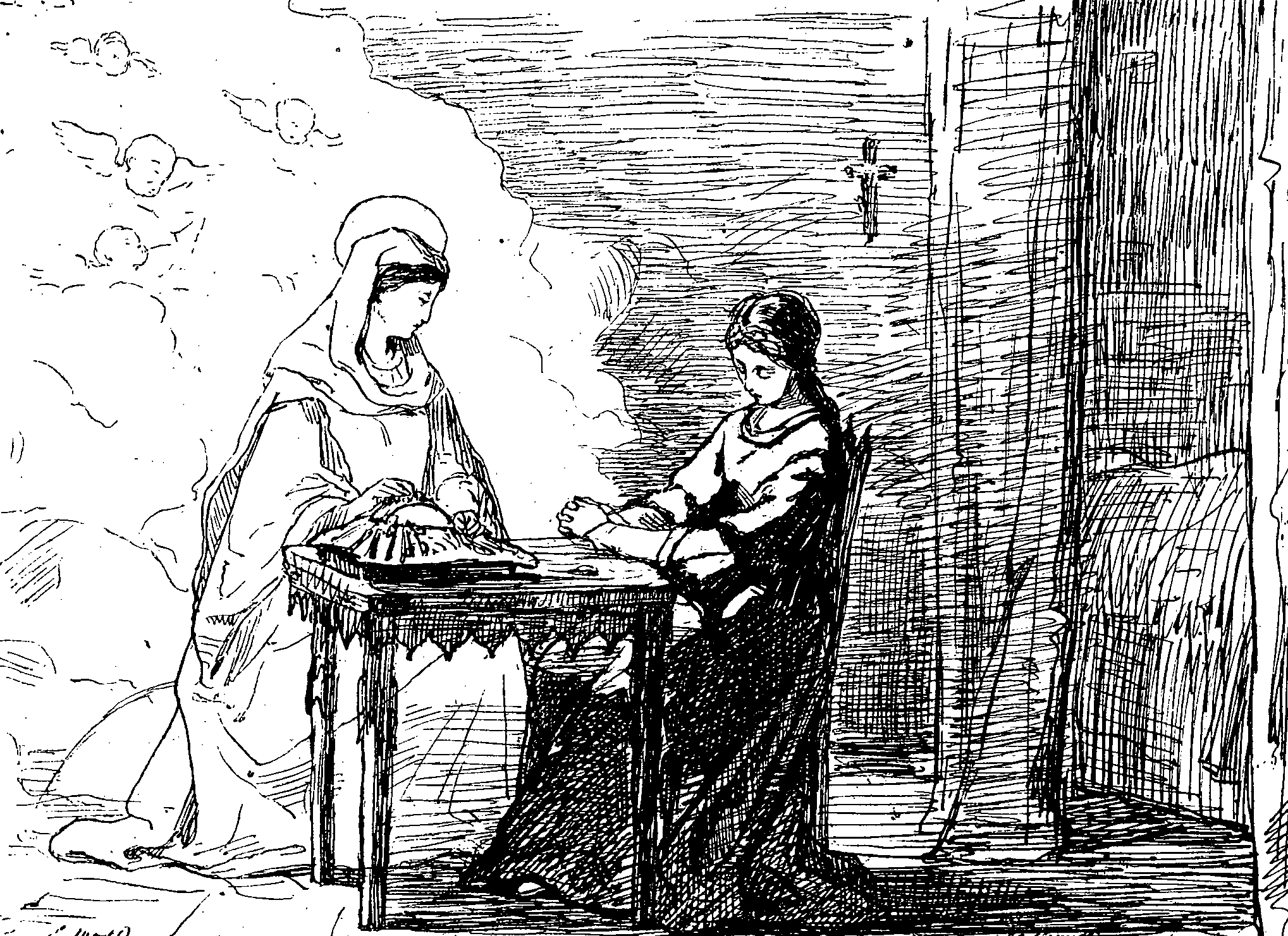
The illustration accompanying Lonlay’s ‘Légende du point d’Argentan’ from the journal La fantaisie Parisienne (1874)
Although you wouldn’t know it from the illustration to Lonlay’s story, Argentan lace is a needle lace, similar to that of nearby Alençon, and like Alençon laces its success owed much to the mercantilist policies of Louis XIV’s minister of finances, Jean-Baptiste Colbert (1618-1686), who objected to French aristocrats spending their money on foreign luxuries and thus enriching other princes. If equally fine manufactures could be established in France, money would stay at home. Particular suppliers in designated towns were granted royal privileges, including Argentan in 1665. Tastes changed and Argentan lacemakers suffered numerous ups-and-downs: it was, apparently favoured by Madame du Barry, Louis XV’s ‘maîtresse en titre’, but not by Marie-Antoinette, known to prefer less heavily decorated laces. Even so, in the last decade before the French Revolution, more than 1000 women were employed in lacemaking in Argentan and the surrounding countryside.[3]
The Revolution effectively destroyed the trade: needle lace is an even more expensive luxury than bobbin lace, and with aristocrats’ emigration, the Terror, war and ruin, there was simply no market for it. Despite attempts to revive it under Napoleon I, all manufacture had effectively ceased by the first decade of the nineteenth century. And with its demise grew the legend of a lost stitch, the ‘bride picotée’. Over time the two legends — of divine intervention and the lost stitch — would fuse.
In January 1874 the sub-prefect of the arrondissement, Alphonse Béchard, in conjunction with the mayor of Argentan, Emmanuel Lebouc, launched a campaign to revive needle-lace in the town, primarily as an economic venture to support poor women and girls. Béchard approached Ernest Lefébure whose family ran a lace business in Bayeux which had a reputation for revitalising old lace techniques. Lefébure explained that, to discover the secret of making Argentan lace, he needed not only examples of old lace but also the patterns on which lacemakers worked. As it happened, a few years before, the nuns of the Hospice de Saint-Thomas had discovered a load of old laces and patterns, at least one with some threads still attached, in an attic. Lefébure passed these on to one of his most skilful employees, Désirée Hamel. Once she had worked out the technique, Hamel was brought to Argentan to set up a lace workshop in the Benedictine convent. The nuns also ran an orphanage and Hamel taught Argentan point both to the nuns and to the orphan girls.[4] By 1878, when Hamel won a silver medal at the Paris World Fair, there were about forty lacemakers employed in the manufacture of Argentan lace, and the business survived, thanks to the active support of the chaplain of the order, abbé Leboulanger, until the First World War. The Benedictine nuns of Notre Dame Abbey still maintain the tradition.[5] Although we have no definite proof of this, we suspect Lonlay’s story was part of a deliberate campaign to generate interest in this venture.
As a response to female unemployment the project can only be viewed as a partial success; even before 1914 young women had turned their back on lacemaking as too poorly remunerated. But the stories concerning Argentan lace took on a life of their own and were repeated in many different forms. In 1883 a British writer with a penchant for stories about artistic French women, Margaret Roberts (1833-1919), brought out a novel Bride Picotée, named for the famous lost stitch. Set in Burgundy during the French Second Empire (1852-1870), the story turns on the ardent desire of a young, disabled, orphan lacemaker Else to acquire the knowledge of this stitch from an elderly neighbour, La Brisarde, the last practitioner of Argentan point, who is equally determined never to give up her family’s birthright: ‘when engaged with those points of her craft which were her special secret she locked the door, and even stopped up the keyhole with jealous care.’[6] She had already resisted the blandishments of one would-be aristocratic patron who had hoped to revive the manufacture. We may return in another post to this lace-obsessed novel which, despite many implausibilities, does at least explain how a particular technique could become a family secret. Because needle lace is so time consuming, individual makers only worked on their own particular part of the pattern, as a ‘réseleuse’ or ‘remplisseuse’ or other specialist. There were few ‘assembleuses’ who could put the whole together.
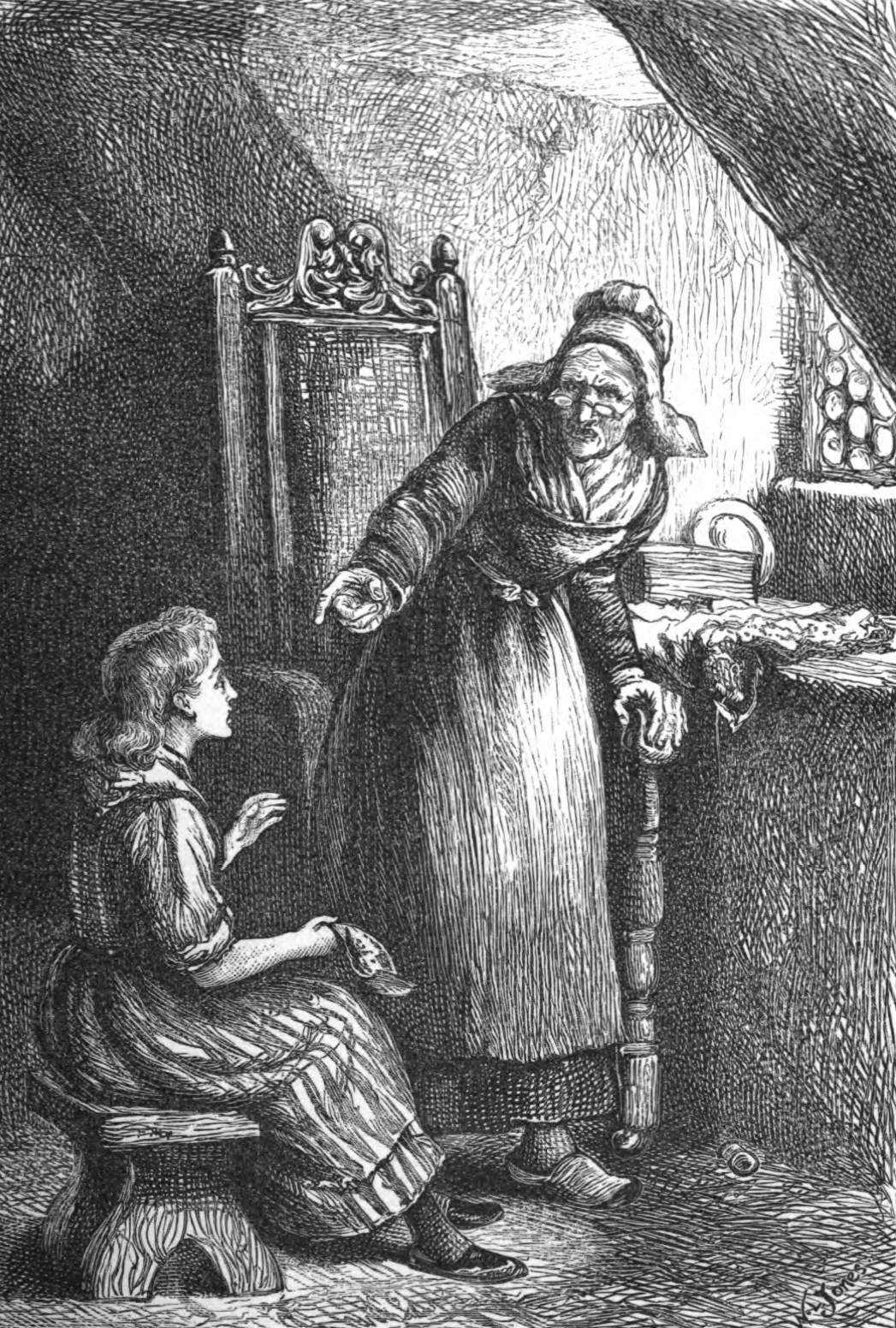
The aged lacemaker La Brisarde refuses to teach Argentan point to the orphan Lise, an illustration from Margaret Roberts’ novel Bride Picotée (1883)
In 1904 the legend of the Virgin’s intervention was revived in musical form. Léon Boschet’s two act play combined the story with another Argentan legend, about a Parisian merchant who had come to the town to buy laces, and made a vow to build a clock-tower for the church of Saint-Germain (at the end of the rue de la Vicomte) if he should escape brigands on his return journey to Paris.[7] Boschet was from the region, and this was not his only musical celebration of the lacemakers of Normandy.[8]
Boschet’s operetta does not appear to have taken off, but perhaps it inspired an altogether more successful work, the one act operetta ‘La légende du point d’Argentan’, which was first performed in December 1906 at the Opéra-Comique in Paris. The composer was Félix Fourdrain (1880-1923) and the librettists Arthur Bernède and Henri Cain. Although in a romantic idiom that was passing out of fashion, it remained part of the repertoire of the Opéra-Comique for many years afterwards, as well as being regularly performed around the country.[9] Oddly, the piece is set not in Argentan but in a hovel near Granville on the Normandy coast where a desperate young lacemaker, Rose-Marie, is nursing a sick, indeed dying child through a storm. Her sailor husband, luckless in his search for work and so incapable of buying the necessary medicine or even food, threatens murder-suicide as the only resolution to their plight. Rose-Marie, however, puts her trust in the Virgin and her hope that she can rediscover the ‘magic stitch’, the secret of Argentan point lace. The cardinal de Rohan has promised 1000 gold écus to the person who can make the lace he wants to present to the queen (there is a vague echo here of the ‘Diamond Necklace Affair’). Although her eyesight is failing, Rose-Marie hopes to win the prize, and vows to cover the steps to the Virgin’s altar with her bobbins if she succeeds (Fourdrain, like Lonlay, was under the impression that Argentan point is a bobbin lace). An old beggar woman comes to her door and Rose-Marie, despite her poverty, offers her food and shelter from the storm. The old woman tells her the miraculous origin of Argentan lace: three centuries before spiders’ threads had woven themselves into a diadem that adorned a statue of Mary. But Rose-Marie is exhausted and falls to sleep over her pillow. Then the stranger reveals herself as the Virgin: while the lacemaker sleeps, angels come and take threads from Mary’s headdress to weave into celestial lace, singing an ‘Ave Maria’ while they work.

Marcel Mültzer’s costume design for Rose-Marie in Fourdrain’s ‘La légende du point d’Argentan’, available on the BNF Gallica website
Regular visitors to this site will recognize many of the motifs in this representation of a lacemaker. Lacemakers’ special relationship with the Virgin has already been explored in the poetry of Guido Gezelle and the legend of Serena of Bruges. Rose-Marie sings a lullaby to her sick child not unlike Desrousseaux’s ‘le p’tit quinquin’. That lacemakers’ suffering and sacrifice can redeem men is a motif in much nineteenth century literature, such as Dickens’ ‘Mugby Junction’.
Some of the same themes were picked up in two French silent films which seem to have some connection to Fourdrain’s operetta, though both are set in the Middle Ages rather than the pre-revolutionary period. In the film ‘La légende du point d’Argentan’ (Radio, 1907), a poor girl must complete her lace for the grand lady Anne d’Argentan before the morning or she will not have the money to find food for her grandmother. When she is too exhausted to continue, a statue of the Virgin comes to life to finish the work for her.[10] ‘Le rêve de la dentellière’ (Lux, 1910) offers a very similar narrative in which a lacemaker falls asleep and is replaced at her pillow by the Virgin, who then carries the product to the castle herself, and returns with the money while the girl is still sleeping.[11] (We have not been able to view either of them in their entirety: we’re relying on summaries, but some scenes from the latter film can be found here.)

A still from ‘Le rêve de la dentellière’ (Lux, 1910), Centre national du cinéma et de l’image animée, catalogue des Films restaurés et numérisés
There are many lace legends, but to date the legend of Argentan point lace is the only one we’ve discovered that inspired painters, musicians and film-makers, alongside writers.
[1] Selina Baring Maclennan, Gaston La Touche: A Painter of Belle Epoque Dreams (Woodbridge, 2009).
[2] Marquis Eugène de Lonlay, ‘Légende du point d’Argentan’, La fantaisie parisienne 6:16 (September 1874): 7-8.
[3] Jean Moulinet, La Dentelle à l’aiguille en Basse Normandie (Argentan, 1912), p. 97.
[4] Ernest Lefébure, ‘Point d’Argentan. Se fait-il par les anciens procédés? Est-il aussi beau que celui d’autrefois? A-t-il conservé une grande valeur?’, Annuaire normand 46 (1880): 145-154. To understand precisely what it was that Hamel recreated, consult Brigitte Tambrun and Veronique Thomazo, ‘La technique du “ point d’Argentan ” dévoilée’ (2019).
[5] Danièle Foury, ‘Les bénédictines, garantes de la tradition de la dentelle d’Argentan’, Ouest-France (22 July, 2019). See https://www.dailymotion.com/video/x7du7v5
[6] Margaret Roberts, Bride Picotée (London, 1883), p. 18.
[7] We have not yet tracked down a copy of this text, we are relying on a short summary in Bulletin de la Société historique et archéologique de l’Orne 23 (April 1904), p. 230. It was performed in April 1904 at the Theatre Athénée-Saint-Germain in Paris.
[8] See his ‘Les Dentelles de l’Orne’ (Argentan, 1902).
[9] Félix Fourdrain (music), Henri Cain and Arthur Bernède (lyrics), La légende du point d’Argentan (Paris, 1906). Fourdrain also set André Alexandre’s poem ‘La dentellière de Bayeux’ to music in 1914.
[10] Christel Tailllebert, ‘Collection Alan Roberts (II): Films primitifs et messages religieux. Regards sur différentes strategies cinématographiques’, 1895, revue d’histoire du cinema 19 (1995): 59.
[11] François Amy de la Bretèque, ‘Présence de la littérature française du Moyen Âge dans le cinéma français’, Cahiers de recherches médiévales et humanistes 2 (1996): 157.


